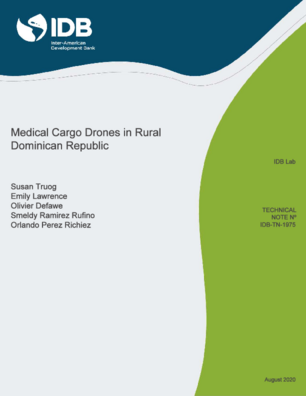Medical Cargo Drones in Rural Dominican Republic
Date
Aug 2020
Autonomous unmanned vehicles (UAS) or Drones, similar to many other interventions such as the internet, GPS and nuclear energy, derived from applications designed for military purposes.
In the 21st century drones technology advanced due to a reduction of production costs of smaller electro-mechanical systems such as gyroscopes and accelerometers that were critical components of mobile technology and smartphones. The lower production costs for these parts opened the door for multiple applications in agriculture, security, health, logistics, sports and humanitarian aid. Many of these applications have the potential to increase business productivity and improve access to services for the broader population.
This report examines one area of drone application with the greatest potential impact, health. This report presents results from an evaluation of the versatility of drone operations within the health sector, and the associated costs of operating drones in region where access to basic health services is limited due to the topography of the land. This evaluation is informed by data collected on more than 150 flights made over a period of two years, between primary care centers and hospitals in the province of San Juan de la Maguana in the Dominican Republic.
In the 21st century drones technology advanced due to a reduction of production costs of smaller electro-mechanical systems such as gyroscopes and accelerometers that were critical components of mobile technology and smartphones. The lower production costs for these parts opened the door for multiple applications in agriculture, security, health, logistics, sports and humanitarian aid. Many of these applications have the potential to increase business productivity and improve access to services for the broader population.
This report examines one area of drone application with the greatest potential impact, health. This report presents results from an evaluation of the versatility of drone operations within the health sector, and the associated costs of operating drones in region where access to basic health services is limited due to the topography of the land. This evaluation is informed by data collected on more than 150 flights made over a period of two years, between primary care centers and hospitals in the province of San Juan de la Maguana in the Dominican Republic.




